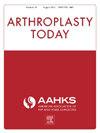人工智能方法在髋关节假体识别和解决放射结果测量中的应用
IF 2.1
Q3 ORTHOPEDICS
引用次数: 0
摘要
放射学评估对于髋关节置换术的成功至关重要,因为正确定位的假体表明良好的长期结果。该项目旨在开发一种新的基于人工智能(AI)的方法,该方法可以(1)自动识别x线片中髋关节表面置换假体的存在,(2)从使用前后(AP)和侧位x线片的二维平面图像中高精度地计算假体的放射颈轴角(NSA)。方法采用计算机视觉和模式识别算法对股骨干和假体区域进行识别,提取它们各自的角度进行NSA计算。然后使用临床医生生成的AP x线片NSAs作为基础事实,使用ai生成的AP和侧位NSAs作为特征来训练神经网络(NN)。计算Spearman相关和Kruskal-Wallis检验,以探索最终人工智能生成的AP放射学NSAs与临床生成的AP放射学NSAs之间的任何显著关联。计算了使用和不使用NN模型的平均绝对误差(MAE)和r平方值,以识别模型的准确性和可变性。结果人工智能最终生成的AP x线片NSAs与临床生成的AP x线片NSAs有统计学意义(rs = 0.93, P <;. 01)。未加NN的MAE、R2和rs分别为3.09、0.37和0.83 (P <;. 01),分别。与NN相关的MAE和R2分别为1.94和0.53。结论人工智能识别人工髋关节置换假体是可行的。通过结合其他特征,如侧位NSA,该模型可以提供AP x线片NSA的准确预测,非常接近实际情况。本文章由计算机程序翻译,如有差异,请以英文原文为准。
Artificial Intelligence Approach in Hip Prosthesis Identification and Addressing Radiographic Outcome Measures
Background
Radiographic assessment is crucial for the success of a hip arthroplasty procedure as a correctly positioned prosthesis indicates favorable long-term outcomes. This project aims to develop a novel artificial intelligence (AI)–based method that can (1) automatically identify the presence of a hip resurfacing prosthesis in radiographs and (2) calculate the radiographic neck-shaft angle (NSA) of the prosthesis from 2-dimensional plane images using both anterior-posterior (AP) and lateral radiographs with high accuracy.
Methods
Using a computer vision and pattern recognition algorithm, the femur shaft and prosthesis regions were identified, and their respective angles were extracted for NSA calculation. A neural network (NN) was then trained using clinician-generated AP radiograph NSAs as ground truths and AI-generated AP and lateral NSAs as features. Spearman's correlation and Kruskal-Wallis tests were calculated to explore any significant association between the final AI-generated and clinician-generated AP radiographic NSAs. Mean absolute error (MAE) and R-squared values were calculated with and without the NN model to identify the model's accuracy and variability.
Results
There was a statistically significant correlation between the final AI-generated AP radiographic NSAs and the clinician-generated AP radiographic NSAs (rs = 0.93, P < .01). MAE, R2, and rs without the NN were 3.09, 0.37, and 0.83 (P < .01), respectively. MAE and R2 with the NN were 1.94 and 0.53, respectively.
Conclusions
This study demonstrates that the identification of hip resurfacing prostheses using AI is feasible. By incorporating additional features such as the lateral NSA, the model can provide an accurate prediction of the AP radiographic NSA, closely approximating the ground truth.
求助全文
通过发布文献求助,成功后即可免费获取论文全文。
去求助
来源期刊

Arthroplasty Today
Medicine-Surgery
CiteScore
2.90
自引率
0.00%
发文量
258
审稿时长
40 weeks
期刊介绍:
Arthroplasty Today is a companion journal to the Journal of Arthroplasty. The journal Arthroplasty Today brings together the clinical and scientific foundations for joint replacement of the hip and knee in an open-access, online format. Arthroplasty Today solicits manuscripts of the highest quality from all areas of scientific endeavor that relate to joint replacement or the treatment of its complications, including those dealing with patient outcomes, economic and policy issues, prosthetic design, biomechanics, biomaterials, and biologic response to arthroplasty. The journal focuses on case reports. It is the purpose of Arthroplasty Today to present material to practicing orthopaedic surgeons that will keep them abreast of developments in the field, prove useful in the care of patients, and aid in understanding the scientific foundation of this subspecialty area of joint replacement. The international members of the Editorial Board provide a worldwide perspective for the journal''s area of interest. Their participation ensures that each issue of Arthroplasty Today provides the reader with timely, peer-reviewed articles of the highest quality.
 求助内容:
求助内容: 应助结果提醒方式:
应助结果提醒方式:


